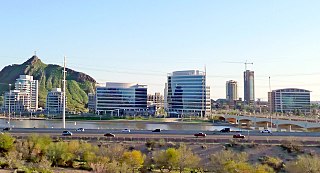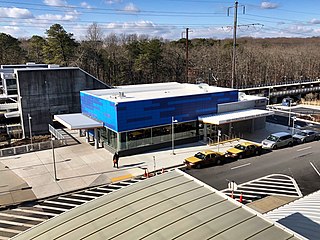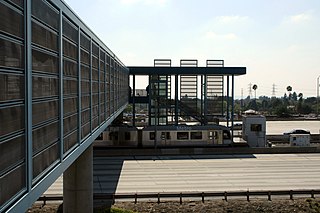
Tempe is a city in Maricopa County, Arizona, United States, with the Census Bureau reporting a 2020 population of 180,587. The city is named after the Vale of Tempe in Greece. Tempe is located in the East Valley section of metropolitan Phoenix; it is bordered by Phoenix and Guadalupe on the west, Scottsdale and the Salt River Pima–Maricopa Indian Community on the north, Chandler on the south, and Mesa on the east. Tempe is also the location of the main campus of Arizona State University.

The Los Angeles County Metropolitan Transportation Authority (LACMTA), commonly branded as Metro or L.A. Metro, is the agency that plans, operates, and coordinates funding for most of the transportation system in Los Angeles County. The agency directly operates a large transit system that includes bus, light rail, heavy rail (subway), and bus rapid transit services; and provides funding for transit it does not operate, including Metrolink commuter rail, municipal bus operators and paratransit services. Metro also provides funding and directs planning for railroad and highway projects within Los Angeles County. In 2021, the system had a total ridership of 227,718,700 and had a ridership of 809,300 per weekday as of the first quarter of 2022.

Los Angeles Union Station is the main railway station in Los Angeles, California, and the largest railroad passenger terminal in the Western United States. It opened in May 1939 as the Los Angeles Union Passenger Terminal, replacing La Grande Station and Central Station.

BWI Airport Station is an intermodal passenger station in Linthicum, Maryland near Baltimore–Washington International Airport (BWI). It is served by Amtrak Northeast Corridor intercity trains, MARC Penn Line regional rail trains, and several local bus lines.

Intermodal passenger transport, also called mixed-mode commuting, involves using two or more modes of transportation in a journey. Mixed-mode commuting is often used to combine the strengths of various transportation options. A major goal of modern intermodal passenger transport is to reduce dependence on the automobile as the major mode of ground transportation and increase use of public transport. To assist the traveller, various intermodal journey planners such as Rome2rio and Google Transit have been devised to help travellers plan and schedule their journey.

North Hollywood station is a combined rapid transit and bus rapid transit (BRT) station in the Los Angeles Metro Rail and Metro Busway systems. It is the northwestern terminus of the B Line subway and eastern terminus of the G Line BRT route. It is located at the intersection of Lankershim Boulevard and Chandler Boulevard in the NoHo Arts District of the North Hollywood neighborhood in the San Fernando Valley of Los Angeles.
The Valley Metro Regional Public Transportation Authority, more popularly known as Valley Metro, is the unified public brand of the regional transit system in and around the Phoenix, Arizona, metropolitan area, responsible for public transit. Within the system, it is divided between Valley Metro Bus, which runs all bus operations, and Valley Metro Rail, which is responsible for light rail operations in the Valley. In 2021, the combined bus and rail system had a ridership of 13,832,000, or about 49,200 per weekday as of the first quarter of 2022.

Baltimore Light RailLink is a light rail system serving Baltimore, Maryland, United States, as well as its surrounding suburbs. It is operated by the Maryland Transit Administration. In downtown Baltimore, it uses city streets. Outside the central portions of the city, the line is built on private rights-of-way, mostly from the defunct Northern Central Railway, Baltimore and Annapolis Railroad and Washington, Baltimore and Annapolis Electric Railway. In 2021, the system had a ridership of 2,718,100, or about 7,800 per weekday as of the first quarter of 2022.

Van Nuys station is a station on the G Line of the Los Angeles Metro Busway system. It is named after adjacent Van Nuys Boulevard, which travels north-south and crosses the east-west busway route and is located in the Van Nuys district of Los Angeles, in the San Fernando Valley. Adjacent to the station is the G Line's bicycle path.

Pittsburgh, surrounded by rivers and hills, has a unique transportation infrastructure that includes roads, tunnels, bridges, railroads, inclines, bike paths, and stairways.

Chatsworth station is an intermodal passenger transport station in the Los Angeles neighborhood of Chatsworth, California, United States. It is served by Amtrak intercity rail service, Metrolink commuter rail service, Los Angeles Metro Busway bus rapid transit, and several transit bus operators.

Valley Metro Rail is a 28.2-mile (45 km) light rail line serving the cities of Phoenix, Tempe, and Mesa in Arizona, USA. The network, which is part of the Valley Metro public transit system, began operations on December 27, 2008. In 2021, the system had a ridership of 7,250,400, or about 22,700 per weekday as of the first quarter of 2022.

RTD Bus and Rail is a transit system in the Denver, Colorado, metropolitan area. Operated by the Regional Transportation District (RTD), it currently runs 86 local, 23 regional, 14 limited, and 3 skyRide bus routes plus some special services. It also includes 8 light rail lines and an additional 4 commuter rail lines with 78 stations and 113.1 miles (182.0 km) of track.

Sierra Madre Villa station is a light rail station on the L Line of the Los Angeles Metro Rail system. It is located in the median of Interstate 210, at Sierra Madre Villa Avenue, after which the station is named, in Pasadena, California. The light rail station opened on July 26, 2003, as the northern terminus of the original Gold Line, then known as the "Pasadena Metro Blue Line" project. This station and all the other original and Foothill Extension stations will be part of the A Line upon completion of the Regional Connector project in 2022.
Public transportation in Phoenix, Arizona consists primarily of buses, a 28-mile (45 km) light rail system, and minor additional services. Most transit services run under the name Valley Metro; local cities, counties, and other agencies in the Phoenix area have agreed to use the Valley Metro name. Public transport in the Greater Valley of the Sun exists in a number of modes: local, express, and RAPID commuter buses; neighborhood circulators; dial-a-ride; vanpool service; an online carpool-matching system, and METRO light rail.

Valley Metro Bus is a transit bus system for public transport in Maricopa County, Arizona, United States. In 2021, the system had a ridership of 5,708,700, or about 26,500 per weekday as of the first quarter of 2022. Buses are operated by private companies contracted by Valley Metro and the City of Phoenix. Service currently operates throughout the broader Phoenix Metropolitan Area. All buses have wheelchair ramps or lifts, and except for paratransit vehicles, all buses have bike racks.
The following is a timeline of the history of the city of Phoenix, Arizona, United States.

The San Bernardino Transit Center is an intermodal transit center in downtown San Bernardino, California, United States. It is owned and operated by Omnitrans, the area's public transportation agency.

The Tempe Streetcar, referred to as the Streetcar Line on regional transit maps, is a streetcar extension of Phoenix's Valley Metro Rail system. Construction began in 2017, and the line opened for service on May 20, 2022. It serves 14 stops across three miles of track serving various parts of the city's downtown, as well as the Tempe campus of Arizona State University, with the Valley Metro Rail main line.























